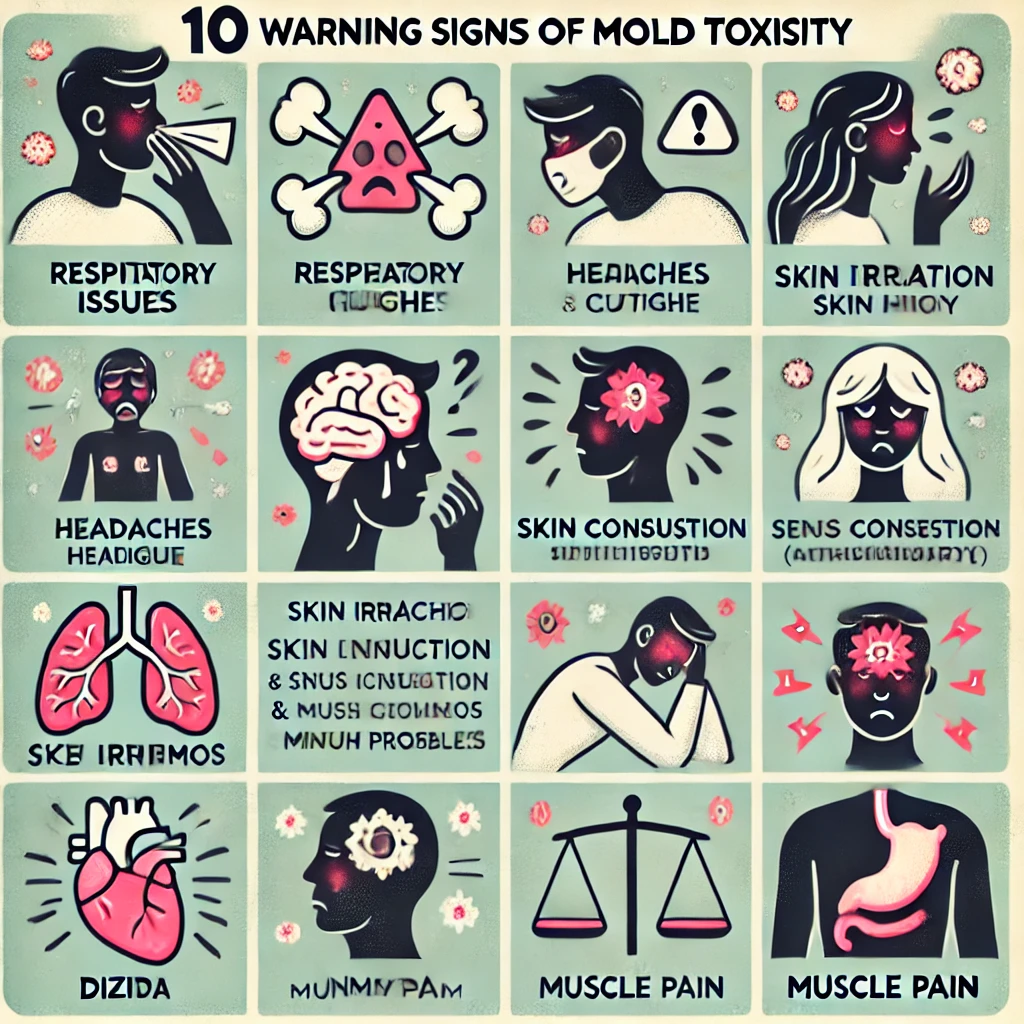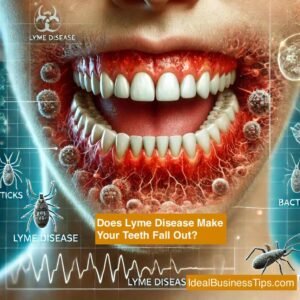Understanding Mold Toxicity: Stachybotry toxicity in everyday practice can be nondiagnostic and has severe health consequences if one is exposed to damp or water-damaged property. It must be stated that this is an extensive guide that will serve to explain the ten signs of mold toxicities (10 Warning Signs of Mold Toxicity) to the public. The precise identification of these signs may be vital once the appropriate treatment and intervention strategies are implemented.
What is Mold Toxicity?
Mold illness occurs when people are exposed to mold spores for an extended period; conditions arising from mold exposure are worse for immunocompromised persons or those with sensitive skin. Molds cause allergens, irritations, as well as toxic compounds which are known as mycotoxins. It is therefore important to learn about the 10 warning signs of mold toxicity so as not to aggravate the effects on our health.
10 Warning Signs of Mold Toxicity are given below:
1. Respiratory Issues
The symptoms that are most likely to warn you that you have mold toxicity include respiratory issues. People who come into contact with mold can suffer from constant coughing, sneezing, and sore throat among other ailments, including asthma especially if the person suffers from this ailment. These symptoms are due to the reaction of the immune system of the body to breathe in mold spores carried by the air, which causes inflammation of the respiratory system and irritation of the mucous membranes of the bronchi.
2. Increased Allergic Reactions
Mold aggravates the allergy that one may have or cause breathing problems if one’s allergy is related to it. Some of the symptoms that are more apparent with the presence of allergies from mold are red, itchy eyes, skin rash, and runny nose. Such symptoms worsen when you are within a specific environment, where there is mold accumulation. This is an important early sign of mold illness.
3. Fatigue and Weakness
Some of the effects of mold that result from long-time exposure include unexplained fatigue and weakness. This is usually masked and can be easily explained as much work, less sleep, and fatigue. However, if one is fatigued irrespective of the amount of sleep, he or she should consider exposure to molds as a reason.
4. Persistent Headaches
Mold exposure can also result in constant headaches. It is stated that these headaches can be mild to severe and may occur along with other symptoms of mold exposure. If you discover that headaches are more prolonged when you remain in particular settings, this may be a sign of mold toxicity, or mold illness.
5. Poor Memory and Concentration
Symptoms such as impaired memory and focus can be developed from mold toxicity. It can present in the form of forgetfulness of tasks or an inability to concentrate on work or discussions that are taking place. If these symptoms are seen and there is no apparent reason, then one should suspect mold exposure.
6. Sensitivity to Smell
People with mold poisoning may also experience a new or exaggerated sense of smell and may become very sensitive to odors other than those related to mold, such as normal, mildew smells. This sensitization can make it impossible to tolerate being in areas containing molds; it is a sign of mold toxicity.
7. Dizziness and Disorientation
Other effects that can be a result of exposure to molds include neurological effects for instance dizziness or even the feeling of being off balance. Such symptoms may manifest at any time and are brief, but may be repeated several times. These are some of the symptoms that are likely to be caused by mold exposure in case they occur frequently.
8. Digestive Issues
Mold exposure can also impact the Gastrointestinal Tract, and could cause vomiting, and stomach upset or irritation, and this could be in the form of Diarrhoea or Pains in the abdomen. Some of these problems include digestive disorders which result from the body’s response to mycotoxins which are produced by mold spores; when ingested or inhaled they are toxic.
9. Injury and disease of muscle and bones, such as arthritis and arthralgia
One rather vague sign that indicates that a person might be dealing with mold toxicity is joint pains and muscle cramps. These symptoms can be attributed to so many other illnesses but may show up mostly in people who have been exposed to molds. These are some painful symptoms that are brought about by inflammation as a result of mold exposure.
10. Mood Swings and Irritability
As if that is not enough, mold also has an impact on one’s mood, such that one may feel ‘’moody’ or become easily irritated. Fungus also leads to a feeling of uncomfortable and unwell, this affects the mood and stress of a person.
Preventing and Handling of Mold Toxicity
To avoid mold poisoning it is all-important that humidity is well regulated, air circulation is well done and more so water damages are well solved on time. If you think that the mold present is toxic, it is advisable to seek the help of a professional for tests and removal of mold and at the same time, see a doctor.
Thus having knowledge and actions towards the Ten signs that show that your house is toxic with mold you are safe and your health from the dangers posed by molds is secure.
Therapies Used in the Management of Mold Toxicity
Stachybotrycose can become a dangerous health problem and it requires medical and ecological intervention for recovery. Here are some treatment strategies for those suffering from mold toxicity: Here are some treatment strategies for those suffering from mold toxicity:
1. Mold exposure and how to recognize it in the home and school environment Its Identification and Eradication
The first thing involved in managing mold toxicity is to exclude exposure to mold sources. This may mean contacting a professional mold removal service to evaluate and answer the mold issue in your home or your workplace. This entity is more of a fungus and thrives more where there is moisture than anywhere, then where there is water damage.
2. Medication for the Symptoms That Present Themselves in the Short Term
Antihistamines and Nasal Sprays: In allergies, first-generation antihistamines can be bought over the counter, or second-generation antihistamines can be prescribed by a doctor to reduce symptoms including those related to the respiratory system that is; runny nose, itching eyes, and sneezing. Nasal corticosteroid sprays may also be prescribed to reduce inflammation as well as swelling in the nasal passageway hence removing blockage.
Inhalers: These may include bronchodilators for wheezing or shortness of breath, and inhaled corticosteroids to reduce the swelling of the airways.
Detoxification Therapies: Taking into consideration the fact that mycotoxins are retained in the body, some physicians may advise other treatments with a view of eliminating the toxins from the body, for instance through the use of activated charcoal or other courses of action that can immobilize toxins in the gastrointestinal tract.
3. Long-Term Medical Care
For those people who have been affected seriously by the effects of mold exposure, they may require longer healthcare involvement. This could include follow-up with a healthcare provider with whom one has been receiving treatment for mold exposure and its effects.
4. Dietary Adjustments
However, consumption of a balanced diet that enhances the immune system can be of added advantage. There are some recommendations as to the ways that the body can be managed for mold toxicity, including consumption of fresh fruits and vegetables mainly and avoidance of sugars and processed foods.
5. Supplements
Some supplements are known to help the body combat the impact of mold toxicity. For instance, Vitamin D, omega-3 fatty acids, and probiotics may have a positive effect on the immune system of the human body. It is always important to get advice from a doctor before taking any new supplement if one has other medical conditions or is on other medications.
6. Environmental Changes
Before that, it is important to preserve such conditions that do not encourage mold to grow after the remediation process is completed. Eliminate the use of humidifiers and air conditioners in areas with high humidity and increase the supply of fresh air, controlling leakage. Ventilation also plays an important role in decreasing mold spores in the air with daily cleaning and Air purifiers being of immense benefit.
7. Psychological Support
When it comes to the effects of mold on human health, it is also worthy of note that individuals who have been exposed to mold and individuals who for one reason or another continue to experience chronic symptoms of the sickness are bound to have their mental health impacted to a reasonable extent. Seeking help from a mental doctor on how to handle stress, anxiety, or depression that may be occasioned by mold exposure is possible.
8. Educational and Support Groups
Social support is another source, probably to find groups or discussion forums of people with similar issues of mold toxicity. Everyone knows that it is greatly reassuring to talk to people who have similar problems and who can offer some helpful advice.
FAQs (10 Warning Signs of Mold Toxicity)
1. What is mold toxicity?
Mold illness is a condition that is a result of being exposed to toxic molds and their spores for a long time which in turn leads to the development of more serious health complications. These molds that are produced create mycotoxins that can be fatal to human beings and animals in instances where one breathes in the air, eats food that has been contaminated by the mold, or comes into contact with the mold most especially the skin.
2. What are the 10 warning signs of mold toxicity?
The most important of such indications include breathing difficulties, more frequent and severe episodes of allergy, weakness and tiredness, chronic headache, memory and concentration impairment, increased sensitivity to smell, loss of orientation, gastrointestinal disorders, joint and muscle pain, and drastic changes of mood.
3. What impotent does mold cause?
The health effects of mold are mostly on the respiratory system but can also affect the nervous system skin and the immune system. Symptoms are from skin-related symptoms such as rashes, and respiratory-related diseases such as asthma, to the neurological effects where one can experience symptoms such as headaches or even memory loss.
4. Who are the people believed to be at risk of experiencing the toxicity effects of molds?
However, everyone can get affected by mold toxicity and those at more risk are people with suppressed immunity, respiratory ailments such as asthma or allergic reactions, and people living in damp or mold-infested regions.
5. How do I test for mold in my home?
Mold testing can be carried out using different kits that are available at home or one can hire the service of a mold inspection company. These tests are used to find the existence of mold spores in the air or if they are present on any particular surface.
6. How can I eliminate mold-sick building syndrome?
Minor mold formation can be washed with water and soap solution Scooping and soap solution can be used readily for cleaning mold breakout. If the infestation is heavier or if the mold is present in things like dry walls then the work should be left to mold removal companies.
7. Can mold toxicity be treated?
Yes, mold toxicity can be treated but this involves the elimination of the mold exposure and then treating the symptomology. Medical care may comprise prescription drugs to address respiratory complaints or allergic reactions. This information however should not be deemed sufficient enough to be self-diagnosed or self-treated; one has to seek the help of a physician in this.
8. How severe can mold exposure be, and what long-term effects might it have on human health?
9. What has to be done so that do not find mold in their homes again?
This can be obtained with the help of controlling the humidity and having a humidity rate between 30% to 50%, proper ventilation, fixing the leaks, and drying the water-affected areas within the span of 24 to 48 hours to avoid mold formation.
10. What is worse, do I have legal rights if I rent a house that turns out to have mold?
Yes, landlords are legally required to make and keep their premises habitable and free of mold infestations. If you ever discover mold in a rental premise, you are supposed to inform your landlord about this as soon as possible. If the issue will not be fixed, one may be required to consult local health departments or housing authorities.
Because mold-related issues are critical in the prevention of good health and sustainable living environments, it is important to understand mold toxicity. Preventative actions suggest that if one feels there are mold problems, then the best thing to do is to act on them.






